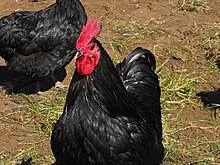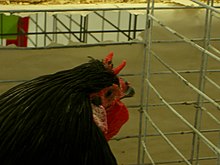
The American Game is an American breed of game fowl, chickens bred specifically for cockfighting. It has many color varieties, and may also be kept for ornament.
Rumpless chickens are characterised by caudal dysplasia, the absence of the pygostyle or caudal appendage – the "parson's nose". This is the result of inheritance of an autosomal dominant trait. The mutation which causes it is unknown; two candidates have been proposed.

The Welsummer or Welsumer is a Dutch breed of domestic chicken. It originates in the small village of Welsum, in the eastern Netherlands. It was bred at the beginning of the twentieth century from local fowls of mixed origin: Rhode Island Reds, Barnevelders, Partridge Leghorns, Cochins, and Wyandottes. In 1922–23, steps were taken to fix a standard after the birds began to show a good deal of uniformity. The eggs were originally exported for the commercial egg trade. Some stock was exported to the United Kingdom, and the breed was added to the British Standard in 1930.

The Silkie is a Chinese breed of chicken named for its atypically fluffy plumage, which is said to feel like silk and satin. The breed has several other unusual qualities, such as black skin and bones, blue earlobes, and five toes on each foot, whereas most chickens have only four. They are often exhibited in poultry shows, and also appear in various colors. In addition to their distinctive physical characteristics, Silkies are well known for their calm and friendly temperament. It is among the most docile of poultry. Hens are also exceptionally broody, and care for young well. Although they are fair layers themselves, laying only about three eggs a week, they are commonly used to hatch eggs from other breeds and bird species due to their broody nature. Silkie chickens have been bred to have a wide variety of colors which include but are not limited to: Black, Blue, Buff, Partridge, Splash, White, Lavender, Paint and Porcelain.

The Leghorn, Italian: Livorno or Livornese, is a breed of chicken originating in Tuscany, in central Italy. Birds were first exported to North America in 1828 from the Tuscan port city of Livorno, on the western coast of Italy. They were initially called "Italians", but by 1865 the breed was known as "Leghorn", the traditional anglicisation of "Livorno". The breed was introduced to Britain from the United States in 1870. White Leghorns are commonly used as layer chickens in many countries of the world. Other Leghorn varieties are less common.

The Barnevelder is a Dutch breed of domestic chicken. It resulted from cross-breeding between local Dutch chickens and various "Shanghai" birds imported from Asia to Europe in the later part of the nineteenth century; these may have been of Brahma, Cochin or Croad Langshan type. It is named for the town and gemeente (municipality) of Barneveld, in Gelderland in the central Netherlands. The hens are good layers of large brown eggs and, unlike some other breeds, continue to lay well during winter.

The Cochin is a breed of large domestic chicken. It derives from large feather-legged chickens brought from China to Europe and North America in the 1840s and 1850s. It is reared principally for exhibition. It was formerly known as Cochin-China.

The La Flèche, French: Poule de La Flèche, is a rare French breed of dual-purpose domestic chicken. It originates from the département of the Sarthe, in the Pays de la Loire region, and is named for the town and commune of La Flèche in that area, not far from the capital of the Sarthe, Le Mans. The breed was once famous for the fine quality of its meat; since the Second World War, numbers have fallen very low.

The Marans, French: Poule de Marans, is a French breed of dual-purpose chicken, reared both for meat and for its dark brown eggs. It originated in or near the port town of Marans, in the département of Charente-Maritime, in the Nouvelle-Aquitaine region of south-western France.

The Barbu d'Uccle or Belgian d'Uccle, Dutch: Ukkelse Baardkriel, is a Belgian breed of bearded bantam chicken. It was first bred in the town of Uccle on the outskirts of Brussels, in central Belgium, in the early years of the twentieth century. It is a true bantam, with no standard-sized large fowl counterpart, and is one of eleven Belgian true bantam breeds.

The Houdan or Poule de Houdan is an old French breed of domestic chicken. It is named for its area of origin, the commune of Houdan, in the département of Yvelines to the west of Paris. It belongs to the crested chicken group, is muffed and bearded, has an unusual leaf-shaped comb, and has five toes on each foot rather than the usual four.

The Faverolles is a French breed of chicken. The breed was developed in the 1860s in north-central France, in the vicinity of the villages of Houdan and Faverolles. The breed was given the name of the latter village and the singular is thus also Faverolles, not Faverolle. The final "s" is silent in French.

The Crèvecœur is an endangered historic breed of crested chicken from the Pays d'Auge, in the Calvados département of Normandy, in north-western France. It is named after the commune of Crèvecœur-en-Auge. It is related to the La Flèche and to other Norman breeds such as the Caumont and Caux and the extinct Pavilly; the Merlerault was formerly considered a sub-type of the Crèvecœur.

The Alsacienne or French: Poule d'Alsace is a breed of domestic chicken from Alsace, in eastern France. It was selectively bred in the 1890s, at a time when Alsace was part of the German Empire. Unlike most other French breeds, it has not been cross-bred with imported Oriental stock.

The Bielefelder Kennhuhn or Bielefelder is a German breed of domestic chicken. It was developed in the area of Bielefeld in the 1970s by Gerd Roth, who cross-bred birds of Malines and Welsumer stock with American Barred Rocks to create the breed. Like other breeds with Barred Rock parentage, it is auto-sexing – chicks of different sexes can be distinguished by their colour. There is a bantam version, the Bielefelder Zwerg-Kennhuhn.

Long-crowing chicken breeds are characterised by the unusually long-drawn-out crow of the cocks, which may in some cases last for up to 60 seconds. The oldest references to long-crowing cocks are from China. Long-crowing breeds are found in the Far East, in Turkey, in the Balkans and in western Germany.

Coucou de Rennes is a French breed of chicken.

The Krüper is a German breed of creeper chicken. It originates in the former Duchy of Berg, now the Bergisches Land in western Germany, and is one of three chicken breeds from that area, the others being the Bergische Kräher and the Bergische Schlotterkamm. It belongs to the group of original European creeper breeds. The breed has normal-sized and bantam varieties.

The Bourbonnaise is a French breed of chicken.

The Niederrheiner is a German breed of chicken. It is named for the Niederrhein or Lower Rhine region where it originated in the early twentieth century, and derives principally from the Dutch North Holland Blue meat chicken. It was recognized in Germany in 1943. In the twenty-first century it is an endangered breed.


















































